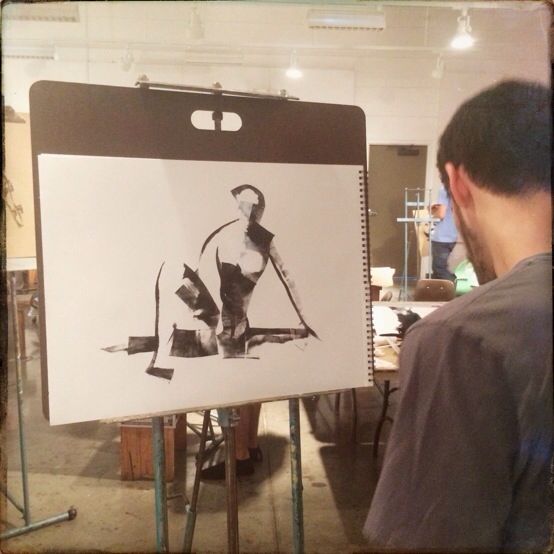Limiting the Lines
Watching Danijel work with the rollers was mesmerizing and took me back to printmaking days and my work with monotypes. Upon returning home I got my rollers from my print studio and began attacking the final Black.Light pieces with both rollers and putty knives. I was very happy with the results. Danijel is certainly the master of the rollers and I’m so appreciative that he turned me onto them again. They’re the perfect counterpoint to detail.
I teach an Advanced Representational Drawing class and got the students messing with the rollers and the putty knives. I was very apprehensive the first time out with them on those tools. I really thought it was going to turn into a cluster. But they clicked right into it and were quickly doing some of what I believe are their best drawings. It forces them to simplify.
The problem I ran into the other day was that the students all seemed to be falling into a mode where they were trying to do basically greyscale paintings. As a result the drawings suffered. They weren’t really “seeing” what was in front of them because they were too busy trying to blend everything and take it to some place more like painting. Lots of fixing going on rather than trusting in the marks the were making. Lots of blending and softening and what they would end up with was a tepid, sort of lackadaisical drawing that wasn’t really a drawing and wasn’t really a painting.
So I made them stop and squeeze out only black acrylic. I told them they could use fifteen lines with only a roller and black. Each mark could be something like five to eight inches long, depending on how long the paint would hold out, which wasn’t long. Lots of groans. Haha! But they dug in.
The pose ended up being something like eight- to ten minutes. One student, as you’ll see, kept count of the strokes on the side of his drawings.
This was a wakeup call for the students. Suddenly each mark had to mean something. They had to be frugal and zero in on the best use of each mark. What they couldn’t do was to cover up their mistakes or, to quote Scott Hampton, polish turds.
They were the best drawings they’d done. Everyone was surprised (except me).
So we did that for awhile, then I told them they could have fifteen strokes with black and five strokes with white, using only a roller. Now they were excited and dove right in. Again, beautiful drawings resulted. No longer were they meandering around being noncommittal. The lines they were putting down were to the point and essential.
Today we did it all again, but they could have eight white lines instead of just five.
It will now be interesting to see where this newfound confidence leads them in other media.






















Hi George, you’re a good man, thanks for sharing with us your knowledge and experiments on painting. I miss the lessons you shared on your old blog. Greetings from Coruña
September 13, 2014 at 7:27 AM
Aleksandar,
Thanks for the kind words. Coruña is so beautiful! I really enjoyed my time there. Everyone was incredibly nice and enthusiastic.
I’ve been digging through the old blog and will be adding some of the older content onto here.
Thanks for following the blog! I’ve also been adding new content to my website and hope you’ll stop by there as well. If you don’t mind spreading the word that would be great!
September 13, 2014 at 11:06 AM
These are stunning George!
September 14, 2014 at 10:40 PM
Thanks, Eli! Wish you were here to dig in on the drawing. Know things are going to be great for you in Rhode Island, though!
September 14, 2014 at 10:48 PM
Great entry and beautiful pieces. Just inspired me to bust out my rollers/putty knifes and try. Especially when I’ve been having “the want” for simplification on my work and having trouble achieving it. Thank you for this.
September 15, 2014 at 2:33 PM
took you long enough to get to this place dude 🙂
November 22, 2014 at 6:15 PM
Haha! Thanks, Mark! 😜
November 22, 2014 at 7:13 PM
Brilliant work as always, and what a fantastic exercise for you students! I’m jealous.
Rachel.C’s piece is excellent, love it.
June 2, 2015 at 8:24 PM